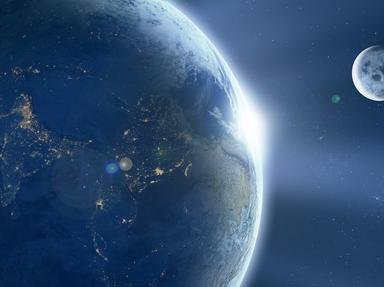Quiz Answer Key and Fun Facts
1. There have been several hypotheses about the origin of the Moon. Which one has been in favor since the Apollo missions of 1969-1972?
2. With the naked eye, one can see the marked contrast between the Moon's dark and bright zones. What do we call the darker areas?
3. What are the visibly lighter areas on the near side of the moon called?
4. The most notable geologic process on the moon is pictured here, as the result of meteoroids striking and excavating the surface. What are these resulting circular features called?
5. What is striking about the far side ("dark side") of the moon, pictured here, as opposed to the near side, which we can see from the Earth (as pictured in question 2)?
6. Why is there a near side and a far side ("dark side") of the Moon in the first place? In other words, why is only one side visible from Earth?
7. Over billions of years of meteoroid impacts, a layer of broken material has covered the the solid rock of the lunar surface. What is the scientific term for this "soil" over the solid rock beneath?
8. As time passed, geologic processes slowed on the Moon. Which of these statements about the Moon is NOT true? (Pick the FALSE statement.)
9. Selenologists have divided the Moon's natural history into large periods, as geologists have done with the Earth's. The period which began 1.1 bya is named after what Renaissance astronomer who constructed a mathematical model of the Moon revolving around the Earth (and the Earth around the Sun)?
10. Besides providing tides, how did the formation of the moon benefit the Earth?
Source: Author
gracious1
This quiz was reviewed by FunTrivia editor
rossian before going online.
Any errors found in FunTrivia content are routinely corrected through our feedback system.
